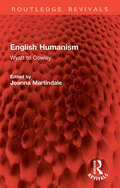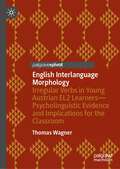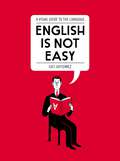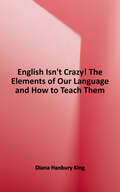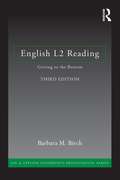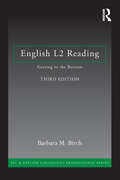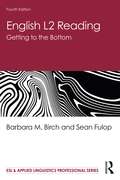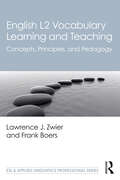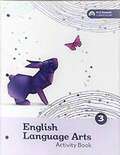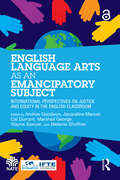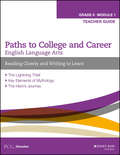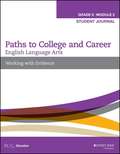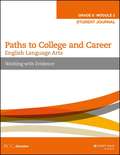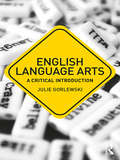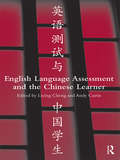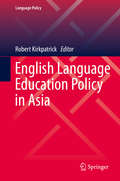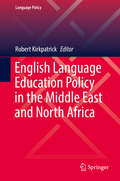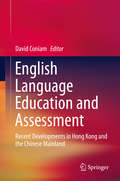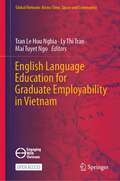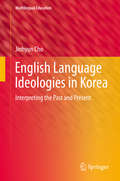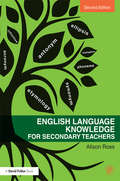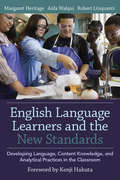- Table View
- List View
English Humanism: Wyatt to Cowley (Routledge Revivals)
by Joanna MartindaleThe literature of the English Renaissance demands some attention to the intellectual and educational background which produced it, in order to be seen in proper perspective. The selection in this book, originally published in 1985, both illustrate the intellectual climate of the English Renaissance and exemplify some of its characteristics, though not strictly literary products. These include education, classicism and imitation, wisdom and eloquence, history and moral philosophy, religion and vernacular scripture. Erasmus has been given a dominant place in the anthology as the main mediator of humanist ideas to England; other authors represented include Castiglione, Machiavelli, Sir Thomas Elyot, Roger Ascham and Ben Jonson. This volume charts precisely the debt of English Renaissance literature to Continental Humanism and the classical revival and is a valuable contribution to an understanding of the literature and society of the time.
English Interlanguage Morphology: Irregular Verbs in Young Austrian EL2 Learners—Psycholinguistic Evidence and Implications for the Classroom
by Thomas WagnerThis book examines psycholinguistic elements of irregular verb morphology in English, using two empirical studies of young language learners in Austria to make evidence-based didactic recommendations for classroom use. The author first provides an up-to-date overview of the so-called past tense debate, encompassing the last four decades of linguistic, psycholinguistic, and cognitive research, before presenting an in-depth discussion of the notion of irregular and semi-regular verbal morphology in both German and English, with a focus on vowel change and apophony. Turning to his original research, he applies generalised linear mixed model analyses as well as conditional inference trees to the behavioural data, avoiding common pitfalls that come with traditional ANOVAs in repeated measure designs, and discusses the concrete implications of the experimental results on second language acquisition and instructed EFL teaching, with a focus on Input Processing. This book will be essential reading for SLA and applied linguistics researchers as well as graduate and postgraduate students in cognitive linguistics, psycholinguistics, and language acquisition.
English Is Not Easy: A Visual Guide to the Language
by Luci GutiérrezA cheeky, sophisticated, and strikingly illustrated guide that leaves generic English reference books in the dust When prominent Barcelona-based illustrator Luci Gutiérrez found herself tuning out in English class, she used her love of drawing to help retain what she’d learned. Ditching the kind of bland and useless phrases that fill most English textbooks, Gutiérrez uses whimsical characters, cheeky dialogue, and even insults to bring vocabulary, grammar, and usage topics to life. Nearly forty-seven million people in the United States speak a language other than English at home, and even most native speakers struggle with subtle distinctions, such as when to use “whether” as opposed to “if.” (For example: I wonder whether I should have added a little more poison to his tea.) Already published to wide acclaim abroad, English Is Not Easy is sure to delight grammar mavens and students of English in America.
English Isn't Crazy: The Elements of Our Language and How to Teach Them
by Diana Hanbury KingThis book is designed as an introduction for the elementary or secondary teacher whose preparation did not include the history and development of our language. I have interwoven important and interesting historical events that have led to the shaping of English with the changes that have occurred over time. Practical suggestions for applying this knowledge with students of any age have been placed in the appendices of this book for ready reference. Included are suggestions of specific techniques that will make teaching this material effective. This book can also be read by motivated high school students.
English L2 Reading: Getting To The Bottom
by Barbara M. BirchEnglish L2 Reading, Third Edition offers teachers research-based insights into bottom-up skills in reading English as a second language and a solid foundation on which to build reading instruction. Core linguistic and psycholinguistic concepts are presented within the context of their application to teaching. The goal is to balance or supplement (not replace) top-down approaches and methodologies with effective low-level options for teaching English reading. The text's pedagogical features-- Questions, Study Guide Questions. Discussion Questions, Spotlight on Teaching sections-- engage readers of the text in moving easily from linguistic details and psycholinguistic data and theory to practical explanations and suggestions for teaching. Two Appendices provide tables that list the graphemes or the phonemes of English.
English L2 Reading: Getting to the Bottom
by Barbara M. BirchEnglish L2 Reading, Third Edition offers teachers research-based insights into bottom-up skills in reading English as a second language and a solid foundation on which to build reading instruction. Core linguistic and psycholinguistic concepts are presented within the context of their application to teaching. The goal is to balance or supplement (not replace) top-down approaches and methodologies with effective low-level options for teaching English reading. The text’s pedagogical features— Questions, Study Guide Questions. Discussion Questions, Spotlight on Teaching sections— engage readers of the text in moving easily from linguistic details and psycholinguistic data and theory to practical explanations and suggestions for teaching. Two Appendices provide tables that list the graphemes or the phonemes of English. Changes in the Third Edition Shift in focus from criticism of whole language methodologies to a more neutral stance —times have changed and the study of lower-level reading strategies is now mainstream Greater focus on linguistic form, along with function and meaning Updated information about reading strategies at each level of the reading process More Spotlight on Teaching sections, one for each chapter New chapter on spelling development
English L2 Reading: Getting to the Bottom (ESL & Applied Linguistics Professional Series)
by Barbara M. Birch Sean FulopEnglish L2 Reading: Getting to the Bottom uses research-based insights to examine bottom-up skills in reading English as a second language. This fourth edition clearly presents core concepts alongside their practical applications to teaching contexts, with updated research findings, a new focus on metalinguistic awareness, and new resources for students. The text’s pedagogical features help readers connect linguistic details and psycholinguistic theory with practical explanations and teaching suggestions. Pre-reading Questions challenge readers to analyze their own experiences. Study Guide Questions allow readers to review, discuss, and assess their knowledge. Discussion Questions elaborate on themes in each chapter, while the new Language Awareness Activities help develop metalinguistic awareness. Three Appendices provide tables that list the graphemes and the phonemes of English, as well as a brand-new dictionary pronunciation guide. New to the fourth edition: Substantially revised and updated research on linguistics New, evidence-based models on the reading process Language Awareness Activities that highlight metalinguistic awareness Word study examples in each chapter For teachers, teacher trainers, reading researchers, or anyone interested in teaching reading, this popular, comprehensive, myth-debunking text provides clear and practical guidance towards effectively supplementing top-down teaching approaches with bottom-up reading strategies.
English L2 Vocabulary Learning and Teaching: Concepts, Principles, and Pedagogy (ESL & Applied Linguistics Professional Series)
by Lawrence J. Zwier Frank BoersAccessible to experts and non-experts alike, this text is a comprehensive entry to teaching and learning vocabulary in ESL and EFL contexts. Firmly grounded in research, it presents frameworks and methods for teaching vocabulary to English L2 speakers. Overviewing key topics as well as providing in-depth research analyses and critiques, Zwier and Boers address all major areas of vocabulary pedagogy and instruction. Organized in four parts, chapters cover the nature of vocabulary and strands of vocabulary research; curricular approaches; and techniques and activities. Readers are introduced to key topics, including teaching multiword expressions, assessment, discourse, and instruction at different levels. Each chapter includes questions, prompts, and activities to foster discussion. A foundational textbook for courses on L2 instruction and teacher-training courses, it is an essential text for students and scholars in TESOL and Applied Linguistics, and provides the pedagogical grounding future English L2 teachers need to effectively teach vocabulary.
English Language 2 class 10 - Karnataka Board
by Karnataka Patyapusthaka SnghaEnglish Language-2 textbook for 10th Standard Kannada medium, Karnataka State
English Language 2 class 7 - Karnataka Board
by Karanataka text book societyIts an 7th standard English language -2 text Book
English Language Arts Research and Teaching: Revisiting and Extending Arthur Applebee’s Contributions
by James D. Marshall Russel K. Durst George E. NewellTaking as a starting point the most enduring insights to emerge from acclaimed researcher Arthur Applebee's scholarship, this volume brings together leading experts to fully examine his work for its explanatory power and its potential to shape current and future research agendas. Focused on the ways in which students learn, schools teach, and assessors evaluate the forms and uses of language needed to flourish and grow, Applebee's work reconceptualized how educators view language development and use in relation to schooling. Organized around three themes--Considering Curriculum as Conversation; Writing as a Tool for Learning; Talking it Out: Class Discussion and Literary Understanding--the 14 fascinating chapters in this book extend and challenge Applebee's insights.
English Language Arts as an Emancipatory Subject: International Perspectives on Justice and Equity in the English Classroom (National Association for the Teaching of English (NATE))
by Andrew GoodwynEnglish Language Arts as an Emancipatory Subject explores the changing nature and history of the English Language as an emancipatory subject, as well as how its current activities and projects address and challenge inequalities. Various forms of critical literacy have established English teaching as a radical force for social justice and subversion. However, the expert contributors to this book question whether English is a force for good in its capacity to develop literate citizens, or, are there larger contemporary complications surrounding it? This book will re-examine the history of English, its present quality as a classroom subject and its future potential to re-establish itself as an agent of social equality and change. Edited by internationally leading scholars from the UK, USA and Australia with contributions from New Zealand and Canada, this work will also inspire English teachers to view their subject as one through which positive differences are imagined, and complex real-life issues are debated and challenged in the classroom. The volume is an excellent overview of research and the latest thinking about the nature of English as an emancipatory subject, its distinguished history and its potential for the future. It will be a key resource for the research and teacher-education community, English teachers, student teachers, and anyone who views English teaching as a catalyst of social change.
English Language Arts, Grade 6 Module 1
by Pcg EducationPaths to College and Career Jossey-Bass and PCG Education are proud to bring the Paths to College and Career English Language Arts (ELA) curriculum and professional development resources for grades 6-12 to educators across the country. Originally developed for EngageNY and written with a focus on the shifts in instructional practice and student experiences the standards require, Paths to College and Career includes daily lesson plans, guiding questions, recommended texts, scaffolding strategies and other classroom resources. Paths to College and Career is a concrete and practical ELA instructional program that engages students with compelling and complex texts. At each grade level, Paths to College and Career delivers a yearlong curriculum that develops all students' ability to read closely and engage in text-based discussions, build evidence-based claims and arguments, conduct research and write from sources, and expand their academic vocabulary. Paths to College and Career's instructional resources address the needs of all learners, including students with disabilities, English language learners, and gifted and talented students. This enhanced curriculum provides teachers with freshly designed Teacher Guides that make the curriculum more accessible and flexible, a Teacher Resource Book for each module that includes all of the materials educators need to manage instruction, and Student Journals that give students learning tools for each module and a single place to organize and document their learning. As the creators of the Paths ELA curriculum for grades 6-12, PCG Education provides a professional learning program that ensures the success of the curriculum. The program includes: Nationally recognized professional development from an organization that has been immersed in the new standards since their inception. Blended learning experiences for teachers and leaders that enrich and extend the learning. A train-the-trainer program that builds capacity and provides resources and individual support for embedded leaders and coaches. Paths offers schools and districts a unique approach to ensuring college and career readiness for all students, providing state-of-the-art curriculum and state-of-the-art implementation.
English Language Arts, Grade 6 Module 2: Working With Evidence, Workbook
by P. C. G. Education StaffStudent Journal to accompany Paths to College and Career, English Language Arts, Grade 6, Module 2.
English Language Arts, Grade 8 Module 2: Working With Evidence (Paths To College And Career Ser.)
by Public Consulting GroupStudent Journal to accompany Paths to College and Career, English Language Arts, Grade 8, Module 2.
English Language Arts: A Critical Introduction (Critical Introductions in Education)
by Julie GorlewskiEnglish Language Arts offers both undergraduates and starting-graduate students in education an introduction to the connections that exist between language arts and a critical orientation to education. Because language influences all aspects of education, English teachers have a unique responsibility to create opportunities for learners to cultivate literacy practices that will empower them to reach their potential. Applying critical and theoretical perspectives to teaching English language arts, this primer considers how meanings are made in intersecting spaces of learners, teachers, and texts. Julie Gorlewski shows future and current teachers how critical English language arts education can be put into practice with concrete strategies and examples in both formal and informal educational settings. With opportunities for readers to engage in deeper discussion through suggested activities, English Language Arts’ pedagogical features include: Model Classroom Scenarios Extension Questions Glossary of Key Terms
English Language Assessment and the Chinese Learner
by Andy Curtis Liying Cheng'This volume addresses a very timely and important topic, and provides both broad and in-depth coverage of a number of large-scale English tests in China, including Hong Kong and Taiwan, and about the Chinese learner.' – Lyle F. Bachman, From the Foreword Building on current theoretical and practical frameworks for English language assessment and testing, this book presents a comprehensive, up-to-date, relevant picture of English language assessment for students in China (Mainland China, Hong Kong and Taiwan) and for Chinese learners of English around the world. Written by well-recognized international scholars in language testing, it covers: the history of tests and testing systems, issues and challenges, and current research in China both test-designers’ and test-users’ points of view on test development and test validation within a range of political, economical, social, and financial contexts in China theoretical/conceptual perspectives on the use of the English language assessment at different levels, including societal, university, and schools empirical research related specifically to test development, curricular innovation, and test validation Given the long history of objective testing and its extensive use in Chinese society, and considering the sheer number of students taking various tests in English in China and elsewhere, an understanding of the impact of English language testing is essential for anyone involved in testing and assessment issues in China and elsewhere in the world. This is a must-read volume for testing and assessment policy makers, curriculum designers, researchers, ESL/EFL materials writers, graduate students, and English language teachers/researchers at all levels.
English Language Education Policy in Asia
by Robert KirkpatrickThis volume offers comprehensive 'state-of-the-art' overviews of educational policies concerning the teaching of English in a large number of Asian countries. Each contribution is written by a leading expert and gives a clear assessment of current policies and future trends. Starting with a description of the English education policies in the respective countries, the contributors then delve into the 'nuts and bolts' of the English education policies and how they play out in practice in the education system, in schools, in the curriculum, and in teaching. Topics covered include the balance between the acquisition of English and the national language, political, cultural, economic and technical factors that strengthen or weaken the learning of English.
English Language Education Policy in the Middle East and North Africa
by Robert KirkpatrickThis volume offers insights on English language education policies in Middle Eastern and North African countries, through state-of-the-art reports giving clear assessments of current policies and future trends, each expertly drafted by a specialist. Each chapter contains a general description of English education polices in the respective countries, and then expands on how the local English education policies play out in practice in the education system at all levels, in the curriculum, in teaching, and in teacher training. Essays cover issues such as the balance between English and the acquisition of the national language or the Arabic language, as well as political, cultural, economic and technical elements that strengthen or weaken the learning of English. This volume is essential reading for researchers, policy makers, and teacher trainers for its invaluable insights in the role of each of the stakeholders in the implementation of policies.
English Language Education and Assessment
by David ConiamThis volume gathers contributions in the closely linked fields of English language assessment and language education. The contributors from China and Hong Kong represent a mixture of established and new scholars. Areas covered in the language education section range across major developments in the redefining of Hong Kong's secondary and tertiary curricula, as well as the huge field of China's vocational education curriculum. Regarding assessment, the contributions reflect major changes in the marking of examinations in Hong Kong, whereby all examinations from 2012 onwards are marked onscreen, to quality control issues in the administration of China's College English Test, which is taken by over 10 million candidates every year.
English Language Education for Graduate Employability in Vietnam (Global Vietnam: Across Time, Space and Community)
by Ly Thi Tran Tran Le Huu Nghia Mai Tuyet NgoThis open access book examines the teaching and learning of English for employability in Vietnamese higher education. Its content is framed within one country to better examine the research issues within the influence of contextual factors. This book investigates how English can contribute to the development of students' employability capitals, particularly in the aspects of human capital, social capital, cultural capital, identity capital, and psychological capital. It presents employers' and employees’ perspectives of how and why English is increasingly important for career development. This book is a collection of discussions and viewpoints from teachers, students, and other stakeholders like employers, graduates, and course coordinators on current practices and their proposed improvements to prepare students for their future education, work and life. Based on empirical evidence, this book calls for repositioning English language education within the employability agenda to elevate its status and increase stakeholders' engagement. This book contributes to current debates on advancing the effectiveness of English language education in non-English speaking countries, as a response to internationalization and globalization.
English Language Ideologies in Korea
by Jinhyun ChoThis volume critically examines the phenomenon of "English fever" in South Korea from both micro- and macro-perspectives. Drawing on original research and rich illustrative examples, the book investigates two key questions: why is English so popular in Korea, and why is there such a gap between the 'dreams' and 'realities' associated with English in Korea? These questions are explored through the eyes of English-Korean translators and interpreters, who represent the professional group most intensely engaged in the zeal for English language mastery. Macro-perspectives focus on historical factors leading to the rise of English, with English-Korean translation and interpreting as a key theme. Micro-perspectives explore the dreams that individuals attach to English and the ways in which they imagine it can transform their lives, and contrast these dreams with the stark realities felt on the ground. The gaps between these dreams and realities are explored from various angles, which include commodification, gender and neoliberalism. The book thus offers fresh insights on how the phenomenon of "English fever" has been created, reproduced, and sustained from both historical and contemporary viewpoints.
English Language Knowledge for Secondary Teachers
by Alison RossIf teachers are to successfully develop their students' English language skills it is vital that they overcome any existing lack of confidence and training in grammar and language concepts. Language Knowledge for Secondary Teachers is an accessible book aiming to equip secondary teachers with the knowledge they need to teach language effectively. It clearly explains the essential concepts for language study, introduces the terminology needed for ‘talking about language’ and shows how this knowledge can be applied to the skills of reading, writing, speaking and listening. This new edition has been fully updated to take into account changes to the curriculum and developments in digital and new media language. Written by an experienced teacher and consultant the book includes: All the grammar knowledge that a secondary teacher needs; Contemporary language examples to which new teachers can relate; A companion website with a numerous activities for use in the classroom linked to each chapter and supported by detailed commentaries to explain how these work in practice (www.routledge.com/ross). By making language teaching a fun and enjoyable experience, this text offers a refreshing resource for any secondary teacher daunted by the prospect of teaching grammar and language.
English Language Learners and the New Standards: Developing Language, Content Knowledge, and Analytical Practices in the Classroom
by Margaret Heritage Aída Walqui Robert LinquantiIn English Language Learners and the New Standards, three leading scholars present a clear vision and practical suggestions for helping teachers engage ELL students in simultaneously learning subject-area content, analytical practices, and language. This process requires three important shifts in our perspective on language and language learning—from an individual activity to a socially engaged activity; from a linear process aimed at correctness and fluency, to a developmental process, focused on comprehension and communication; and from a separate area of instruction to an approach that embeds language development in subject-area activities. In English Language Learners and the New Standards, the authors:Clarify the skills and knowledge teachers need to integrate content knowledge and language developmentShow how teachers can integrate formative assessment in ongoing teaching and learningDiscuss key leverage points and stress points in using interim and summative assessments with ELLsProvide classroom vignettes illustrating key practicesFinally, the authors explain the theories and research that underlie their vision and examine the role of policy in shaping pedagogy and assessment for ELL students.
